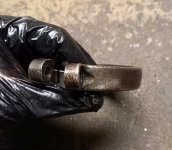AlfaGTA
Diamond
- Joined
- Dec 13, 2002
- Location
- Benicia California USA
Spend some time with a magnifier to look over the quill for any imperfections that might be causing issue installing the quill in the bore.....
Most likely culprit is the quill....The bore would have less chance to get damaged simply due to its construction...(bore)
Have a good look at the area of transition where the clamp ring was nested.....That is where you have been cleaning and working.....
Any suspected burrs or nicks can be addressed locally using a hard "Arkansas" stone
Would not use diamond paste on a close fitting iron assembly that is part of a sliding fit...Iron is porous and will accept the diamond at the molecular level...You will never get it out of the surface and it will promote wear for the life of the casting. This is how diamond laps are made.
You do not want to make the bore any larger..The quill was working before you took it apart....The clearance between the quill and housing is critical. Excess clearance here will affect cutting performance..and surface finish of the machine.
If you must lap the bore i would recommend "Time Saver" lapping paste. It breaks down and will not embed into the iron.....They make two versions, one for soft materials and one for hard materials...they offer a sample kit having both types of varying grits.
Be sure to "clock" the quill to the housing where it originally was. Could likely be very slight errors in the shape of the quill that have found a mating home in the housing....having those out of position will make install harder.
Be sure the clamp ring is not causing issues....if it is cocked at all it will prevent the quill from sliding into the housing..
Try with lock ring removed.
Also, remember that the quill is steel, it grows (expands) at a higher rate than the iron of the housing, handling the quill with your hands will change its size and can cause distortion it its shape and straightness. Make sure the quill has been sitting in still air as is the housing long enough to be stable. (hours)
ATF is a good assembly lube for tight tolerance parts.
Cheers Ross
Most likely culprit is the quill....The bore would have less chance to get damaged simply due to its construction...(bore)
Have a good look at the area of transition where the clamp ring was nested.....That is where you have been cleaning and working.....
Any suspected burrs or nicks can be addressed locally using a hard "Arkansas" stone
Would not use diamond paste on a close fitting iron assembly that is part of a sliding fit...Iron is porous and will accept the diamond at the molecular level...You will never get it out of the surface and it will promote wear for the life of the casting. This is how diamond laps are made.
You do not want to make the bore any larger..The quill was working before you took it apart....The clearance between the quill and housing is critical. Excess clearance here will affect cutting performance..and surface finish of the machine.
If you must lap the bore i would recommend "Time Saver" lapping paste. It breaks down and will not embed into the iron.....They make two versions, one for soft materials and one for hard materials...they offer a sample kit having both types of varying grits.
Be sure to "clock" the quill to the housing where it originally was. Could likely be very slight errors in the shape of the quill that have found a mating home in the housing....having those out of position will make install harder.
Be sure the clamp ring is not causing issues....if it is cocked at all it will prevent the quill from sliding into the housing..
Try with lock ring removed.
Also, remember that the quill is steel, it grows (expands) at a higher rate than the iron of the housing, handling the quill with your hands will change its size and can cause distortion it its shape and straightness. Make sure the quill has been sitting in still air as is the housing long enough to be stable. (hours)
ATF is a good assembly lube for tight tolerance parts.
Cheers Ross


 .
.








